

Modern principles of organizational change management and employee training and development. Home » leadership/management » organizational change, training and learning modern principles of change management, and effective employee training and development in organizations Here are some modern principles for organizational change management and effective employee training and development.
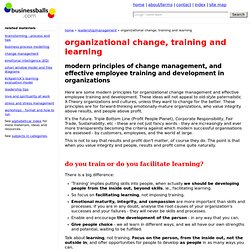
These ideas will not appeal to old-style paternalistic X-Theory organizations and cultures, unless they want to change for the better. These principles are for forward-thinking emotionally-mature organizations, who value integrity above results, and people above profit. It's the future. This is not to say that results and profit don't matter, of course they do. Do you train or do you facilitate learning? There is a big difference: 'Training' implies putting skills into people, when actually we should be developing people from the inside out, beyond skills, ie., facilitating learning. Talk about learning, not training. More about facilitation of learning.
Why? Are the people stupid? Fact one: Nlp - neuro-linguistic programming free theory training guide, nlp definitions and principles. Home » self/personal development » nlp (neuro-linguistic programming) NLP - neuro-linguistic programming - free training introduction, NLP principles and techniques guide This free introduction to NLP is provided by Robert Smith MBA, a leading international practitioner in neuro-linguistic programming and NLP Master Trainer.
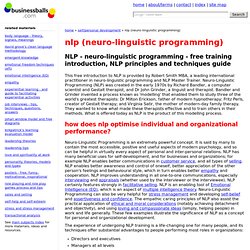
Neuro-Linguistic Programming (NLP) was created in the early 1970s by Richard Bandler, a computer scientist and Gestalt therapist, and Dr John Grinder, a linguist and therapist. Bandler and Grinder invented a process known as 'modelling' that enabled them to study three of the world's greatest therapists: Dr Milton Erickson, father of modern hypnotherapy; Fritz Perls, creator of Gestalt therapy; and Virginia Satir, the mother of modern-day family therapy. Johari window model - helpful for personal awareness and group relationships. Free johari window model diagram (pdf - landscape) free johari window model diagram (pdf - portrait) (The Johari Window diagram is also available in MSWord format from the free resources section.)
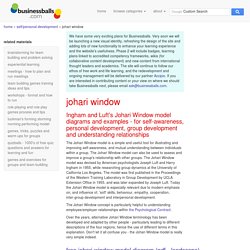
Luft and Ingham called their Johari Window model 'Johari' after combining their first names, Joe and Harry. In early publications the word appears as 'JoHari'. The Johari Window soon became a widely used model for understanding and training self-awareness, personal development, improving communications, interpersonal relationships, group dynamics, team development and inter-group relationships.
The Johari Window model is also referred to as a 'disclosure/feedback model of self awareness', and by some people an 'information processing tool'. N.B. The four Johari Window perspectives are called 'regions' or 'areas' or 'quadrants'. The Johari Window's four regions, (areas, quadrants, or perspectives) are as follows, showing the quadrant numbers and commonly used names: Emotional Intelligence theories - Daniel Goleman's EQ concepts.
This webpage is a new format for mobile/small screens.
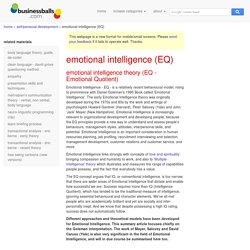
Please send your feedback if it fails to operate well. Thanks. emotional intelligence theory (EQ - Emotional Quotient) Life coaching and personal coaching guide, tips - coaching success, performance, sales, career development; and coaching life-change, leadership, and management. Home » self/personal development » life coaching and personal coaching life coaching tips for business coaching, personal coaching - techniques for coaching success, performance, career and life-change.

Articles - The Coaching & Mentoring Network. Developing your school leadership team – the case for executive coaching by – The Coaching and Communication Centre Copyright Fiona Eldridge Article first appeared in CPD Update March 2003 If you have any comments to add to this topic or would like to be in communication with other people exploring this field then please The Government Strategy Unit’s report, Strengthening Leadership in the Public Sector (Strategy Unit "Strengthening Leadership in the Public Sector" March 2001) urges senior managers to ensure they stay ahead of the challenges facing the public sector – including the modernisation of services, ever-increasing demands from the public and the increased capacity and need for partnerships with the private sector.
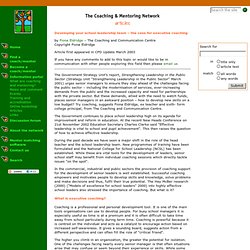
But these demands, allied with the need to watch funds, places senior managers in an awkward position – how to develop new skills on a low budget? The Government continues to place school leadership high on its agenda for improvement and reform in education. Effective Coaching Models To Structure Your Coaching Sessions. There are various effective coaching models which some coaches choose to use to structure their coaching sessions which you may find helpful to guide your coachee through a logical sequence and provide a framework for your coaching session.
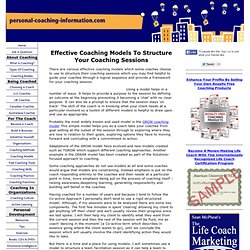
Using a model helps in a number of ways. It helps to provide a purpose to the session by defining an outcome at the beginning preventing it becoming a 'chat' with no clear purpose. It can also be a prompt to ensure that the session stays 'on track'. The skill of the coach is in knowing what your client needs at a particular moment so a toolkit of different models is helpful to draw upon and use as appropriate. Probably the most widely known and used model is the GROW coaching model This simple model helps you as a coach take your coachee from goal setting at the outset of the session through to exploring where they are now in relation to their goals, exploring options they have to moving forward and concluding with a commitment to action. Mike the Mentor - Classic Models. The GROW Model is deservedly one of the best known and widely used coaching models.

It provides a simple yet powerful framework for navigating a route through a coaching session, as well as providing a means of finding your way when lost. It is described in a number of coaching books, including John Whitmore's excellent book Coaching For Performance: Growing People, Performance and Purpose . GROW is an acronym for Goal, current Reality, Options and Will - which are seen as the four key elements of a coaching session.
The GROW Model is described here as it applies to an individual session but part of its strength is that it can equally well be applied to a part of a session, or to series of sessions.